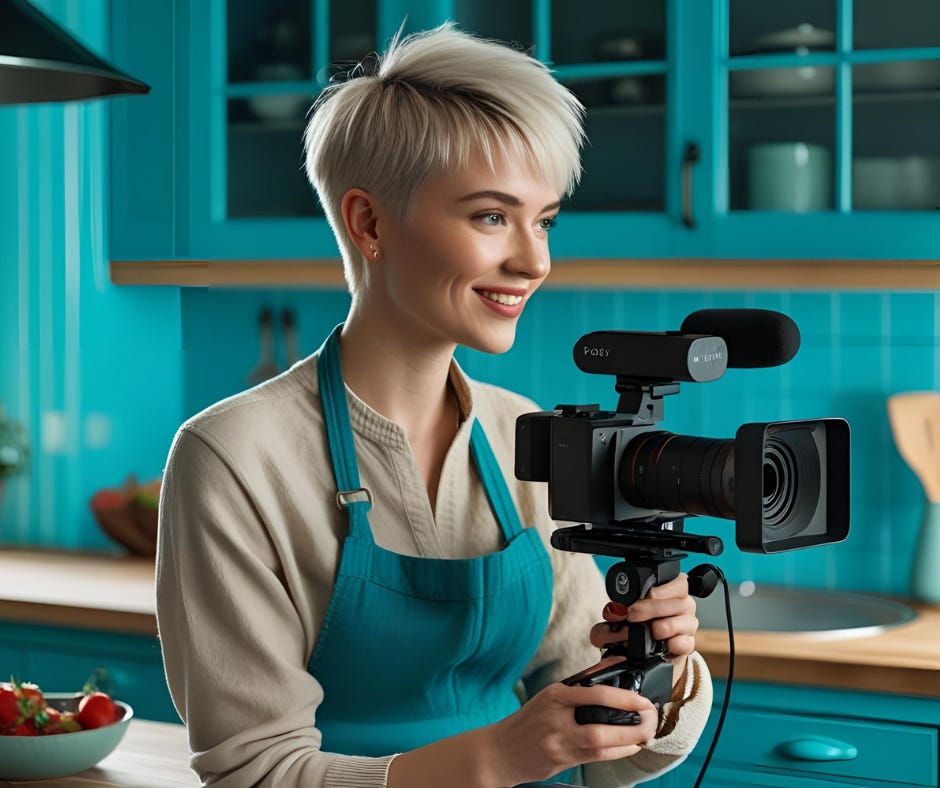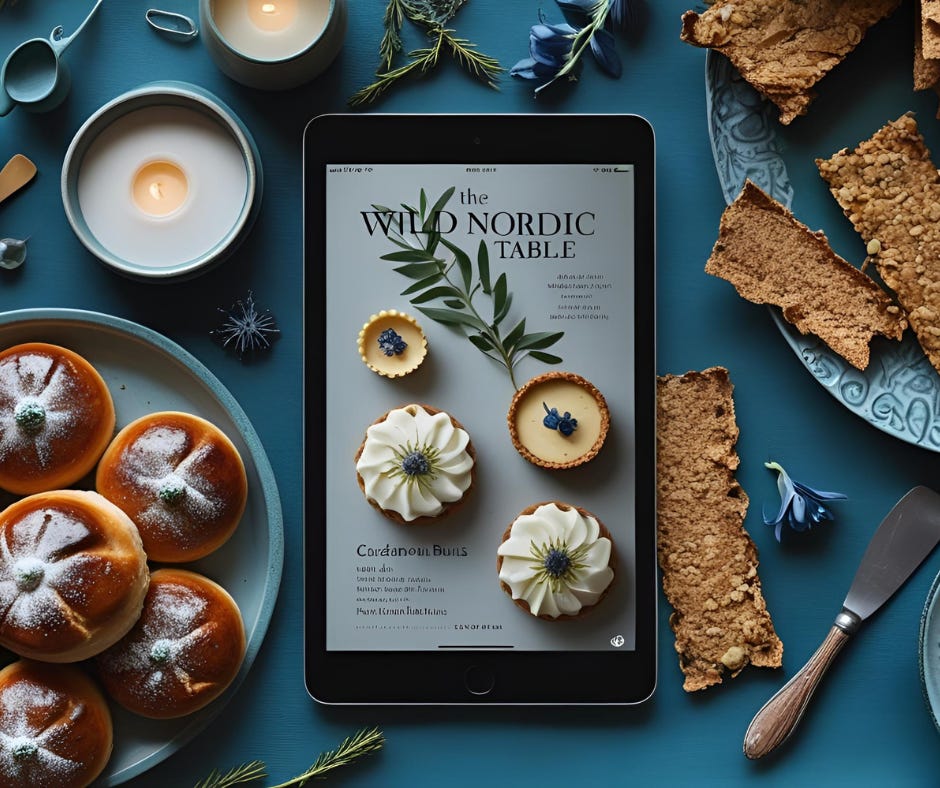Zariah was playing the algorithm game. She just didn’t know the rules.
AI search, Pinterest pins, and the code your content needs to survive.
AI search is rewriting the rules of discoverability, and recipe blogs built on aesthetics alone are starting to slip. Structured content isn’t a nice-to-have anymore. It’s the foundation that platforms like Google (including Gemini), Pinterest, and smart assistants rely on to actually understand your work.
This issue breaks down what structured content really is, how it affects visibility, and why it’s the missing piece in most food blogs. To show you what that looks like in practice, we’re following Zariah, a creator whose content looked polished on the surface but was invisible under the hood.
Let’s get into it.
Zariah had a food blog, and things were going great.
She’d carved out a niche in Scandinavian baking. I know what you’re thinking. Scandinavian baking? But people loved it; think cardamom buns in the winter, elderflower tarts in the spring, and rustic rye crispbread year-round. Her readers came for the coziness and stayed for her easy-to-follow and exact measurements. She shared stories about her Finnish grandmother, her sourdough starter named Elska, and the seasonal rituals that shaped her recipes.
Her brand was beautiful.
Muted pastels. Hand-drawn illustrations. A Substack that read like a lifestyle magazine. She’d recently hired a VA to manage social and a part-time photographer to help with reels. And earlier this year, she took the leap and started working on her first eBook: The Wild Nordic Table.
From the outside, Zariah was doing everything “right.”
She had a business account, a CPA, and a not-so-secret Pinterest strategy that used to bring in 100,000 monthly views. But behind the scenes, things weren’t adding up.
Traffic was down. Ad revenue had plummeted.
And her signature recipe, strawberry rye galettes with lemon thyme, had suddenly stopped ranking.
She Googled it.
Third page. Buried under roundup posts and AI-generated recipe summaries. To make matters worse, one of her old pins showed up with the wrong title and a broken image.
She poured a glass of wine. Scrolled TikTok.
And that’s when she saw it: someone else baking her exact galette, with the same crust fold and all, but without a blog, a link, or any credit.
“If your recipes aren’t structured, AI search can’t find them.”
It was a passing comment in a food creator forum, but it hit hard.
Zariah had heard of structured data before. Something about Schema.org. But she’d assumed her recipe plugin handled all that. Turns out, it didn’t.
And while her blog looked polished on the surface, platforms like Google, Pinterest, and Gemini (Google’s AI assistant) couldn’t understand what her content was. Her recipe titles were cute, but not descriptive. Her instructions were a single chunky paragraph. And her metadata? Practically nonexistent.
That night, she ran her site through Google’s Rich Results Test.
Three red flags. Missing fields. Ineligible for rich results.
Zariah didn’t sleep much.
Wait. What exactly is structured content?
Most recipe plugins only take care of the visual layout. Structured content is about what’s underneath, the code that platforms like Google, Pinterest, and smart assistants read.
A blog post might say:
“Fold the dough over the strawberries and bake for 35 minutes.”
But structured content turns that into something search engines can read, recognize, and reuse:
{ "@context": "https://schema.org/", "@type": "Recipe", "name": "Strawberry rye galettes with lemon thyme", "cookTime": "PT35M", "recipeIngredient": [ "1½ cups rye flour", "½ cup unsalted butter", "1 cup fresh strawberries", "1 tbsp lemon thyme leaves" ], "recipeInstructions": [ { "@type": "HowToStep", "text": "Preheat oven to 375°F. Line a baking sheet with parchment paper." }, { "@type": "HowToStep", "text": "Roll out rye dough and spoon strawberries into center." }, { "@type": "HowToStep", "text": "Fold edges over, sprinkle with lemon thyme, and bake for 35 minutes." } ] }This code doesn’t just look different. It changes everything.
Why this matters now
Structured content used to be a nice-to-have. Now, it’s essential.
Here’s why:
AI search tools like Gemini rely on schema markup to surface recipes in summaries and interactive displays
Pinterest and Google Discover use structured data to feature content in carousels and search feeds
Voice assistants need structured steps to guide users through recipes hands-free
Smart grocery apps and platforms depend on structured ingredients to enable shoppable lists and automated meal planning
If you’ve ever wondered why your pins don’t pull the right title or your rich results don’t show up, structured content is usually the answer.
Zariah’s turning point
Zariah decided to audit 10 of her top-performing recipes.
The results were sobering.
Not only were her plugins missing fields like yield and total time, but her instructions were all mashed into a single paragraph, meaning Google Assistant and Pinterest couldn’t properly display or recommend them.
She started small:
One recipe at a time.
Rewrote the metadata. Broke her instructions into clean, structured steps. Added categories and tags in a consistent format.
Then she ran them through Google’s Rich Results Test again.
✅ Valid
✅ Eligible for rich results
✅ Step-by-step voice guidance enabled
Within a month, her galette recipe climbed from page 3 to page 1 for long-tail keywords.
Pinterest started showing accurate previews.
And her spring content impressions increased by 28%.
She wasn’t just showing up again, she was being understood.
This isn’t just about SEO. It’s about survival.
Platforms are changing faster than most food bloggers can keep up. But structured content is how you future-proof your work:
Recipes become platform-ready—from search to apps to voice
Your content becomes repurposable across newsletters, tools, and tech integrations
You stop chasing visibility and start building content that lasts
If you’ve been relying on plugins, clever intros, or perfect photography to get discovered, this is your signal to look under the hood.
Want to learn how to structure your recipes?
I wrote a blog post breaking this all down:
→ How structured content improves recipe discoverability and performance
Inside:
Schema breakdowns
SEO data
Visual comparisons of structured vs. unstructured content
Actionable tips for getting started
More to explore
I was recently on The Smart Influencer Podcast talking all things future-of-food:
→ Listen to the episode
ICYMI
The first episode of Your Friend in Food is live!
It’s called Everyone Has a Food Story, and it’s mine.
→ Watch on YouTube
Enjoying Blueberri Pi?
This newsletter is free to read, but it takes time (and love) to write.
If Blueberri Pi has helped you feel seen, sparked new ideas, or changed how you think about recipes and content strategy, consider upgrading to a paid subscription.
💙 Paid members get:
Bonus strategy content and prompts
Insider insights from tech founders and platforms
Early access to tools and digital products
Invite-only Q&As and behind-the-scenes breakdowns
And the satisfaction of supporting independent food tech content
It’s $8/month or $80/year and helps me keep sharing real strategies, not just surface-level trends.
If you’re feeling like Zariah, doing everything “right” but still not seeing results, it’s not your fault.
The rules of food content are changing. But you don’t have to chase every trend to keep up. You just need a smarter foundation.
Structured content gives your recipes the visibility, adaptability, and longevity they deserve.
Want help auditing your own recipes? I’ve got something coming soon for paid members that walks you through it.
Until then, take a breath, run your top recipe through Google’s Rich Results Test, and start where Zariah did: one recipe at a time.
Your friend in food,
Sandie
💙 Blueberri Pi is powered by readers like you.






